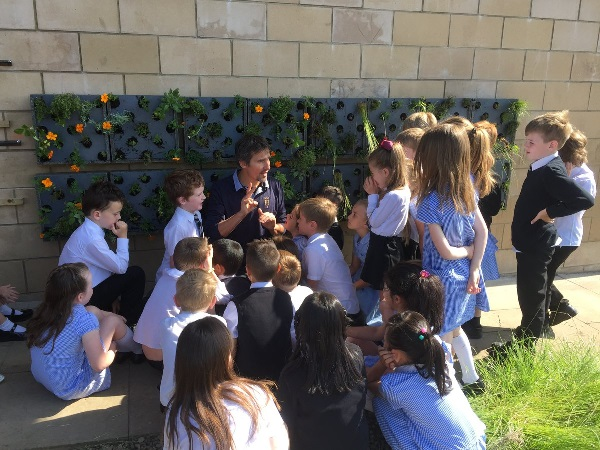Green roofs, when designed well, provide homes for a range of wildlife, especially pollinating insects, and can be used and enjoyed by people to. A green roof installed at Carrongrange High School in Grangemouth is doing just that!
The 300m2 roof garden, installed in 2017, was planted with a range of plants, including Chive, Heathers, Sedums, Lambs ear and a wildflower mat which included a diverse mix of native species. The garden was designed to allow access for pupils and teachers along the entire length of the roof and a cobbled path that goes from one end to another is wide enough to allow access for wheel chairs.
In May 2018, Buglife along with staff from the Inner Forth Landscape Initiative ran three workshops with the schools gardening club. Each workshop invited pupils onto the roof garden to show them the different plants on the roof and the wildlife feeding on them. These workshops also provided opportunities for the pupils to learn how to maintain the garden and what plants to weed and remove.


During the workshops, pupils enjoyed seeing Small copper butterflies, all stages of Seven spot ladybird, Red tailed bumblebees and the leafhopper Cicadella viridis. Not only does this roof provide outdoor space for pupils to use for learning but it provides space for them to sit and relax. Teachers have also enjoyed the use of the garden in lunchtimes and when using it with pupils.
Since the workshops, Buglife have returned to the roof to weed it before the new term started in August 2018. We added in some new herbs, including Thyme, Rosemary, Lavender and Marjoram, that will be great for pollinators but also nice for pupils to touch and smell.
Glorious Green Roofs is an Inner Forth Landscape Initiative project funded by Heritage Lottery Fund and the contribution of the LIFE financial instrument of the European Community delivered as part of the EcoCo LIFE project: https://www.buglife.org.uk/campaigns-and-our-work/habitat-projects/glorious-green-roofs
The roof was installed by ICB (Projects) Ltd. And has won an award for best Green Roof Installation at the NFRC Scottish Roofing Contractor of the Year Awards 2017.







